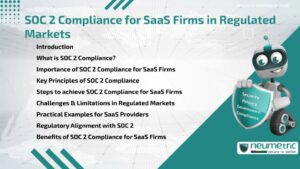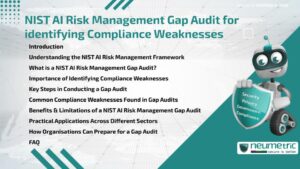Table of Contents
ToggleIntroduction
NIST AI Risk Management Gap Audit is an essential process for Organisations that deploy or manage Artificial Intelligence systems. It helps identify compliance weaknesses, reduce operational Risks & strengthen accountability in AI Governance. The Audit examines how closely an organisation’s practices align with the National Institute of Standards & Technology [NIST] AI Risk Management Framework. By conducting this type of Audit, companies can uncover Gaps in policy, processes & controls that may lead to legal, ethical or reputational Risks. Understanding & applying this structured evaluation supports compliance, enhances transparency & ensures safer adoption of AI technologies.
Understanding the NIST AI Risk Management Framework
The NIST AI Risk Management Framework was developed to help Organisations manage Risks associated with Artificial Intelligence. It provides structured guidelines for addressing issues like bias, transparency, security & accountability. Much like how a building code ensures safety in construction, the Framework ensures AI Systems are trustworthy & aligned with societal values. Organisations that ignore these standards Risk exposing themselves to regulatory action, ethical controversies & a loss of public trust.
For more on the Framework itself, you can explore the NIST AI RMF overview.
What is a NIST AI Risk Management Gap Audit?
A NIST AI Risk Management Gap Audit is a structured Assessment that compares an organisation’s current AI Practices against the NIST Framework. The goal is to identify Gaps between what is expected by the Framework & what is currently implemented. These audits typically review Data Management, model Governance, transparency practices & compliance monitoring. Think of it as a health check-up for AI Systems-diagnosing Risks before they become critical problems.
Importance of Identifying Compliance Weaknesses
Compliance weaknesses are blind spots that could lead to fines, reputational harm or even unintended harm from AI outputs. Identifying these weaknesses early allows Organisations to address deficiencies before they escalate. For instance, a weak data Governance process could cause biased model outputs, which can create ethical & legal complications. Addressing such issues is not just about avoiding penalties but also about fostering trust with Customers & regulators.
Key Steps in Conducting a Gap Audit
Conducting a NIST AI Risk Management Gap Audit usually involves:
- Defining Scope: Identifying which AI Systems & processes to review.
- Collecting Evidence: Gathering documentation, Policies & system outputs.
- Comparing Practices: Evaluating organizational processes against NIST AI RMF standards.
- Identifying Gaps: Highlighting areas where compliance is weak or missing.
- Recommending Improvements: Providing steps to close Gaps & strengthen compliance.
Common Compliance Weaknesses Found in Gap Audits
Organisations often encounter recurring weaknesses during audits, such as:
- Insufficient documentation of AI Decision-making Processes
- Lack of transparency in training data sources
- Weak bias detection & mitigation practices
- Poorly defined accountability structures
- Inconsistent monitoring of deployed AI Models
Each weakness can increase Risks, making the Audit a critical safeguard for responsible AI deployment.
Benefits & Limitations of a NIST AI Risk Management Gap Audit
The benefits of conducting such an Audit include improved compliance, stronger Governance, reduced ethical Risks & greater Stakeholder confidence. However, there are also limitations. The Audit does not automatically solve compliance issues-it only identifies them. Additionally, the Framework itself is voluntary, which means Organisations must be proactive in adopting its recommendations.
A useful perspective on voluntary adoption can be found at the Center for Information Policy Leadership.
Practical Applications Across Different Sectors
A NIST AI Risk Management Gap Audit is relevant across industries. In Healthcare, it ensures AI diagnostic tools follow transparency & safety requirements. In Finance, it supports fair lending practices by addressing algorithmic bias. In Government, it safeguards the use of AI in decision-making processes. These examples illustrate how audits help reduce Risks while enhancing ethical & Regulatory Compliance across sectors.
How Organisations Can Prepare for a Gap Audit
Organisations can prepare by establishing clear AI Governance Policies, documenting processes thoroughly & implementing regular internal reviews. Building a culture of accountability & aligning with NIST’s Core Principles helps ensure that when a Gap Audit occurs, compliance weaknesses are minimized. Preparation is not a one-time activity but an ongoing commitment to responsible AI Practices.
For preparation guidance, see resources on AI ethics & Governance.
Takeaways
- A NIST AI Risk Management Gap Audit is crucial for identifying compliance weaknesses in AI Systems.
- It supports transparency, accountability & alignment with NIST AI RMF.
- Organisations benefit from early detection of Risks, but audits must be followed by Corrective Actions.
- Effective preparation & ongoing Governance practices are key to minimizing weaknesses.
FAQ
What is the purpose of a NIST AI Risk Management Gap Audit?
Its purpose is to identify compliance weaknesses in AI Practices & ensure alignment with the NIST AI Risk Management Framework.
How often should Organisations conduct a Gap Audit?
Organisations should conduct audits annually or when significant changes are made to their AI Systems.
Who should perform a NIST AI Risk Management Gap Audit?
It can be carried out by internal compliance teams or independent Third Party Auditors specializing in AI Governance.
What are the common weaknesses found in these audits?
Weaknesses include poor documentation, lack of transparency, weak bias controls & inconsistent monitoring practices.
Does a Gap Audit guarantee compliance?
No, it only identifies Gaps. Organisations must take Corrective Action to close those Gaps.
Is the NIST AI RMF mandatory?
No, it is a voluntary Framework, but it is widely recognized as a best practice for AI Governance.
How can Small Businesses benefit from a Gap Audit?
Small Businesses gain by reducing Risks, improving trust & demonstrating accountability to Customers & partners.
References
- NIST AI Risk Management Framework
- Center for Information Policy Leadership
- Stanford Encyclopedia of Philosophy – Ethics of AI
Need help for Security, Privacy, Governance & VAPT?
Neumetric provides organisations the necessary help to achieve their Cybersecurity, Compliance, Governance, Privacy, Certifications & Pentesting needs.
Organisations & Businesses, specifically those which provide SaaS & AI Solutions in the Fintech, BFSI & other regulated sectors, usually need a Cybersecurity Partner for meeting & maintaining the ongoing Security & Privacy needs & requirements of their Enterprise Clients & Privacy conscious Customers.
SOC 2, ISO 27001, ISO 42001, NIST, HIPAA, HECVAT, EU GDPR are some of the Frameworks that are served by Fusion – a SaaS, multimodular, multitenant, centralised, automated, Cybersecurity & Compliance Management system.
Neumetric also provides Expert Services for technical security which covers VAPT for Web Applications, APIs, iOS & Android Mobile Apps, Security Testing for AWS & other Cloud Environments & Cloud Infrastructure & other similar scopes.
Reach out to us by Email or filling out the Contact Form…





